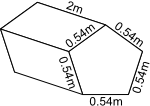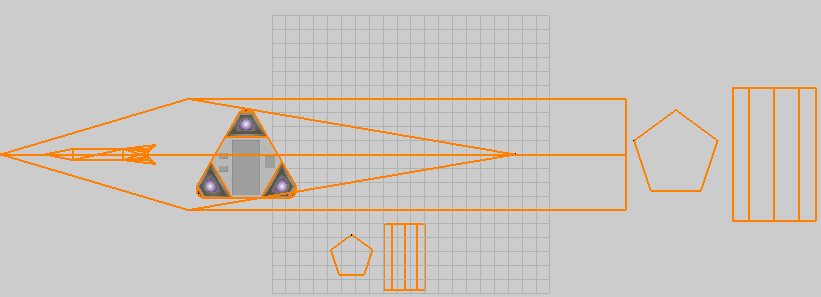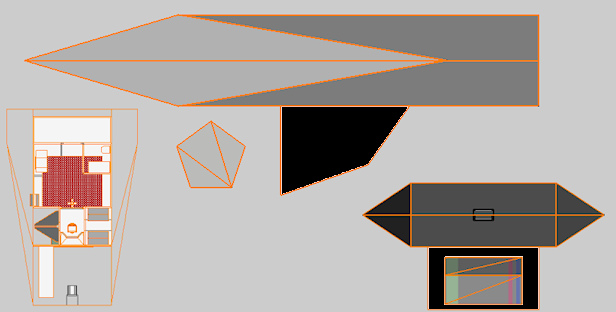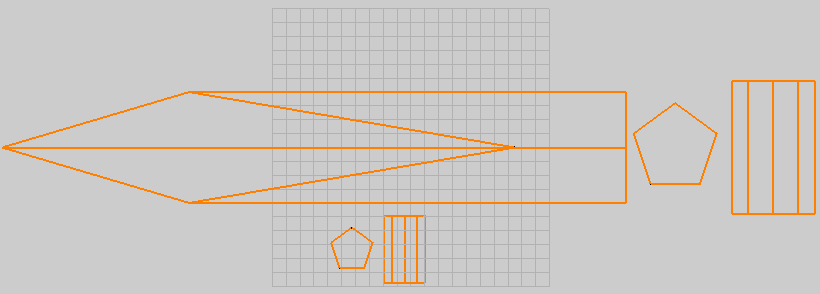Spacecraft Scales
This page came about mainly because of several discussions on the Oolite forums about how it was near nigh impossible to correlate scale in the Oolite game. They're right. Feet and metres are interchangeable in the manual, planets are not to scale with ships and so forth.
I've always wanted to know exactly how big the ships are and always wanted to draw a 3D model of a ship but this scale thing always got in my way so I've decided to try and work out a definitive (at least for me) answer to scale in the same way as the "Unlocking the Frontier" project tried to put together a one-stop timeline for Elite, Oolite and Frontier.
Basic Mass
The first thing to work out, I think, is the size of a cargo canister. They're generally called Tonne Canisters (or TCs) in the manual, denoting a "metric ton". What's the most basic item that could be carried in one of these containers? Everyone knows that water is one of the most fundamental requirements for life on any planet, so I decided to base the actual size of a cargo container on how big it would need to be, at the rough dimensions relative to itself in the game, to carry a metric tonne of water.
This was easy. Each pentagon edge needs to be 0.54 metres in length, and the container needs to be 2m long from one pentagonal edge to the other.
This leads us to Assumption 1: a tonne canister is designed to carry 1 tonne of water at 1 standard "Earth" G.
 So that's the cargo canister size sorted out. Hopefully we can use this in trying to work out how big everything else is. The problem is that it doesn't really fit in with the other sizes in the manual. When physics and a game manual don't gel together, what's a scifi nerd to do?
So that's the cargo canister size sorted out. Hopefully we can use this in trying to work out how big everything else is. The problem is that it doesn't really fit in with the other sizes in the manual. When physics and a game manual don't gel together, what's a scifi nerd to do?
At this point I thought about going and having a look at the ships to see what I could work out with them. I looked at the ship dimensions and saw that the Adder was overall the smallest ship. The stats give it a height of only 8 feet (which in Oolite we decided was the same as a metre). Loading the Adder into Wings3D then loading the cargo container showed a slight problem. The container was HUGE compared to the ship. The Adder is supposed to be able to take two of these on board, and if...
Wait a minute. I seem to remember a conversation some time back that the cargo canister in Oolite is purposely bigger than it should be so that pilots can see them easily - one of the many scale "fudges" in the game (and might even be carried over from Elite). So, simple matter to drop the scale by 50%. After doing so, this is what I could see (click on the image to view full size).
So now we have an 8 metre tall Adder against the fudged Oolite-size cargo canister and the 50% smaller more realistic sized canister. So far, looking good. They seem to be in proportion. The problem is that (using the grey grid as 1m squared as the designers normally specify) the barrel is 4.5 metres tall - over twice the size it should be.
At this point I started to wonder what the interior of a ship should look like, and I started to play with my models in Wings3D. I loaded in a missile model (knowing that the Adder could only carry one) and loaded in the Escape Pod model as well. The texture of the pod handily has a door drawn on it, which gives a rough idea of the scale of the pod.
With the Pod and missile in place, this is what I could see:
 The Escape Pod fits nicely into the profile. The door, however, is the most impressing bit of "evidence" for scale. According to the comparison to the grey boxes in Wings, the door is 4 "units/metres" tall, very similar to the cargo container. The missile is a good size too, and the majority of the models on screen were fitting together nicely. Now if a person was about the same size as the capsule door, then the scale would be about right.
The Escape Pod fits nicely into the profile. The door, however, is the most impressing bit of "evidence" for scale. According to the comparison to the grey boxes in Wings, the door is 4 "units/metres" tall, very similar to the cargo container. The missile is a good size too, and the majority of the models on screen were fitting together nicely. Now if a person was about the same size as the capsule door, then the scale would be about right.
A person is just under 2m in height, maybe 2m for a tall bloke. The sizes on screen look about right. The problem is that if that was the case, then the Adder is about 4m tall rather than 8m as advertised. Even using feet as the unit type doesn't work, because the Adder would be 8 feet tall, which would be about 3 metres, and that doesn't fit at all.
Then I remembered something about the Dark Wheel:
"Alex ordered one. Delivery and fitting would take twenty hours, a standard day. Alex fuelled the ship, next, and stocked up with Xezaorian delicacies"
The canonical "universe" of Elite has messed about with the standard day and therefore the standard week, month and year had to be different too (a major headache when I was trying to write stories - I have pages of time and date calculations somewhere around here). If GalCop could mess around with time, why couldn't they mess around with distance too?
What if the standard metre wasn't the same as ours?
Thus was born Assumption 2: A "GalCop Metre" is 50cm in length. So is a "GalCop Foot"
The problem is that when describing people, humans are now about 4 metres tall. Maybe when talking about ships, people talk in GalCop Metres but anything else is in Standard Metres. Like talking about "hands" when measuring horses?
Hey, it's an idea! An alternative that came to me overnight after writing the above was that maybe the manual was the ONLY thing that used "GalCop Metres", and everyone else considers the Adder to be 4m high. That way assumption 2 isn't really needed, just relabel the sizes to 50% of what they were (and Oolite ship designers would have to remember that 1 Wings3D unit is half a metre.
Anyway, this looked like it could work. The cargo canister at 50% scale is now about 2m (or 4 GalCop Metres) tall (actually a little taller, but the pentagon edges are smaller than 0.54m, which counters it). The door on the escape pod is about 2m tall now too.
Fleshing Out The Insides
Now that I had a rough idea of a size that seemed to work, I had to find some way to check that there would be enough room in the ship for everything that needed to be in it. My preferred way to do this was to try and design the interior of the Adder and see if I could make it look "habitable".
A couple of days of designing the liveable space (leaving enough room for the engineering section, "equipment level" and wingfolding system) left me with the following.
 Overall, I was actually quite surprised and quite impressed with the result. It looked like the scale was working well, and giving enough interior space for a comfortable living environment as well as leaving plenty space in the rest of the hull for the stuff that actually makes it work!
Overall, I was actually quite surprised and quite impressed with the result. It looked like the scale was working well, and giving enough interior space for a comfortable living environment as well as leaving plenty space in the rest of the hull for the stuff that actually makes it work!
The best part of it was that the cargo canisters and the escape pod both fit absolutely perfectly into the layout, making it a very effective interior design (in my opinion). Nothing stands out as glaringly not able to fit and there is plenty of space left over for some of the components to be expanded. There's room for a storage cupboard or some such and room for a table and chair to sit down and eat or otherwise relax.
Further Discussion
Smivs from the Oolite forums postulated that the cargo canister as depicted in Oolite is the correct size, due to the need to contain more voluminous matter than water and that the Adder should carry the 2TC canisters at the 100% size. He also mentioned that they need to be that size in order for the pilot of a ship to be able to see it in order to scoop it, and that NPC Adders in Oolite regularly shed 5 TCs after being blown up. After consideration, I rebutted that it would be unfeasible for the canisters to be as large as depicted as even only 2 would take up more than half the volume of the Adder and 5 would fill the ship over capacity. It also got me thinking about 2 things. The first is inertia and mass and how they work together. Now my physics is a bit rusty so this might be over simplistic. A fully loaded canister of 100% size in the ship would substantially alter the centre of gravity of the ship and seriously affect the manoeuvrability of it. They would also be far far more dangerous should the "artificial gravity" of the ship fail. Secondly, fuel/cargo scoops are fitted that can scoop these things out of space, and the scoop would have to be big enough to take the pod inside. THis would mean it would have to be a little bigger than the pod and there would have to be enough space inside the ship to accept that pod and shift it away from the scoops's egress area so another one can be scooped in.
 The picture to the right illustrates just how big a cargo scoop would have to be in order to be able to accept a 100% scale canister.
The picture to the right illustrates just how big a cargo scoop would have to be in order to be able to accept a 100% scale canister.
Another issue raised was that if a cargo canister was to be used to transport slaves, how would the 50% version be able to fit people and cryogenic storage equipment? My rebuttal to that was that "slaves" would be transported 1 to a pod, and that the life support needs would be seen to by a piece of technology similar to the canonical remLoc mask, which can sustain life in suspended animation in the depths of space.
Wildeblood on the Oolite forum came up with an intriguing concept. The reason that cargo pods look as large as they do on screen is that there is a system built in to them to make them easier to see if they are floating in space. An inflatable envelope expands around the pod, making it seem twice the size as normal and can thus be easily seen from the cockpit. A further expansion to that idea would be that when a ship is in proximity of the pod the bubble automatically deflates and retracts to allow it to be scooped. This would explain why cargo pods "bumping" a ship will cause a little damage.
Feel free to make use of this information and these assumptions if you like. There's still more to cover (like the actual size of a space station, for example). I have started a topic on the Oolite forum about it to see if there are any holes in my theories. Those guys are brilliant at this sort of stuff. If I can convince them, then my science is sound!!

